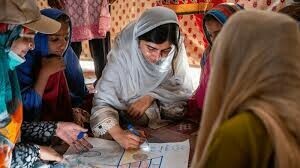GLOBALLY, the geography of poverty has a rural face. Of around 1.4 billion poor worldwide, 70 per cent reside in rural areas of developing countries. Rural development and transformation, therefore, remain central to the goal of poverty reduction enunciated in the Sustainable Development Goals (SDGs).
Pakistan is no exception with its 9.3pc urban poor compared to 54.6pc in rural areas. The majority of this mass is youth as shown by the Sindh Union Council Community Economic Strengthening Support Programme (Success) conducted in eight districts of the province. This programme also collects and shares disaggregated data. Here are some insights about the characteristics of the rural youth.
Mainstream youth initiatives, such as Prime Minister Youth Programme, offering business loans, laptops, fee reimbursement and training opportunities assume basic literacy and skills. Thus, they are biased towards urban youth. Although necessary, such programmes are unlikely to help reduce extreme poverty and the urban-rural divide.
Mainstream youth initiatives and schemes offering business loans and laptops assume basic literacy and skills that have a deep urban bias
The National Human Development Report 2017 highlighted the significance of engaging with youth and forwarded some generic suggestions. The insight gained about the characteristics of the rural youth from the analysis of the poverty scorecard survey data in Sindh calls for customised rural-centric youth policy initiatives due to an excessive gap of knowledge, skills and capacities compared to their urban counterparts.
Here are some of the startling findings about the youth (ages between 15 and 29) in the eight districts covered under Success.
Of the total population of 47.89 million in Sindh, 22.97m (47.96pc) live in rural areas as per the latest census. The eight programme districts namely Dadu, Jamshoro, Larkana, Matiari, Kambar Shahdad Kot, Sujawal, Tando Allahyar and Tando Muhammad Khan have a rural population of 5.69m, according to the poverty scorecard survey undertaken in the Success programme in 2016.
The findings show that one-fourth of the total rural population in the said districts is young (735,499 males and 691,126 females). However, a larger group of future-youngsters (ages between one and 14) comprises 45pc of the total. It means 70.9pc (4.04m) people are below 29 years of age as per the poverty scorecard survey. In all the eight districts, over 50pc people live in rural areas. Amongst the eight districts, Sujawal is mostly rural with 89pc of the people in rural areas while Larkana is the least rural with 53.97pc rural population.
At the national level, up to 30pc of youth is not literate as per the National Human Development Report (2017). The scorecard survey results show that 68.14pc of the rural youth is illiterate. Only 7.42pc and 6.34pc of them have attained education till matric and intermediate levels, respectively. Furthermore, youth with bachelor’s and master’s degrees or above are only 1.96pc and 0.51pc, respectively.
The analysis also shows huge gender discrimination where females’ education attainment is far less than that of males. For instance, the male-female ratio is 62/38 until grade five, 71-29 in grades six to eight, 75-25 in matric, 79-21 intermediate, 79-21 in bachelor’s and 75-25 in master’s or above.
Disparity exists within the districts as well with Sujawal having the least literate youth (16pc) and Larkana the highest (41pc).
Though young, 35pc of the males and 53pc of the females are married in the programme area. As we know, land ownership is skewed in Sindh. Landlessness is positively correlated with illiteracy in our data. The illiterate landless rural youth is 70pc compared to 59pc belonging to families who own land.
What are these young people doing? The scorecard survey results show that 40.9pc of rural youth are engaged in household chores (97pc of them are females). Likewise, 26.1pc work as off-farm unskilled labour (94pc are males). The third highest ranked occupation (8pc) is ‘student’. Despite living in rural areas, only 7pc are involved in farm labour or work as tenants.
Do we expect these young people in rural areas to seek jobs and claim their share in national youth programmes? At least half of them would not be able to do it even if they wished so because 46pc do not have CNICs.
The writer is lead researcher at the Rural Support Programmes Network, Islamabad
Published in Dawn, The Business and Finance Weekly, December 3rd, 2018












































